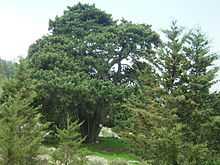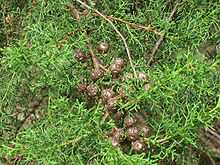Cupressus
| Cupressus | |
|---|---|
 | |
| Cupressus sempervirens | |
| Scientific classification | |
| Kingdom: | Plantae |
| Division: | Pinophyta |
| Class: | Pinopsida |
| Order: | Pinales |
| Family: | Cupressaceae |
| Genus: | Cupressus L. |
| Species | |
|
See text | |
The genus Cupressus is one of several genera within the family Cupressaceae that have the common name cypress; for the others, see cypress. It is considered a polyphyletic group. Based on genetic and morphological analysis, the Cupressus genus is found in the Cupressoideae subfamily.[1][2] The common name comes from Old French cipres and that from Latin cyparissus, which is the latinisation of the Greek κυπάρισσος (kypárissos).[3]
As currently treated, these cypresses are native to scattered localities in mainly warm temperate regions in the Northern Hemisphere, including western North America, Central America, northwest Africa, the Middle East, the Himalayas, southern China and northern Vietnam. As with other conifers, extensive cultivation has led to a wide variety of forms, sizes and colours, that are grown in parks and gardens throughout the world.[4] They are evergreen trees or large shrubs, growing to 5–40 m tall. The leaves are scale-like, 2–6 mm long, arranged in opposite decussate pairs, and persist for three to five years. On young plants up to two years old, the leaves are needle-like and 5–15 mm long. The cones are 8–40 mm long, globose or ovoid with four to 14 scales arranged in opposite decussate pairs; they are mature in 18–24 months from pollination. The seeds are small, 4–7 mm long, with two narrow wings, one along each side of the seed.
Many of the species are adapted to forest fires, holding their seeds for many years in closed cones until the parent trees are killed by a fire; the seeds are then released to colonise the bare, burnt ground. In other species, the cones open at maturity to release the seeds.
Many species are grown as decorative trees in parks and, in Asia, around temples; in some areas, the native distribution is hard to discern due to extensive cultivation. A few species are grown for their timber, which can be very durable. The fast-growing hybrid Leyland cypress, much used in gardens, draws one of its parents from this genus (Monterey cypress C. macrocarpa); the other parent, Nootka cypress, is also sometimes classified in this genus, or else in the separate genus Xanthocyparis, but in the past more usually in Chamaecyparis.
Species
The number of species recognised within this genus varies sharply, from 16 to 25 or more according to the authority followed, because most populations are small and isolated, and whether they should be accorded specific, subspecific or varietal rank is difficult to ascertain. Current tendencies are to reduce the number of recognised species; when a narrow species concept is adopted, the varieties indented in the list below may also be accepted as distinct species. See also the New World species (below) for a likely split in the genus in the future.
Old World species
The Old World cypresses tend to have cones with more scales (8–14 scales, rarely 6 in C. funebris), each scale with a short broad ridge, not a spike. C. sempervirens is the type species of the genus, defining the name Cupressus.
- Cupressus atlantica (Moroccan cypress)
- Cupressus austrotibetica (South Tibet cypress)
- Cupressus cashmeriana (Bhutan cypress)
- Cupressus chengiana (Cheng's cypress) - Conservation status: Vulnerable
- Cupressus duclouxiana (Yunnan cypress)
- Cupressus dupreziana (Saharan cypress)
- Cupressus funebris (weeping cypress)
- Cupressus gigantea (Tibetan cypress) - Conservation status: Vulnerable
- Cupressus sempervirens (Mediterranean cypress)
- Cupressus tonkinensis (Tonkin cypress)
- Cupressus torulosa (Himalayan cypress)
- Cupressus vietnamensis (Vietnamese cypress)
New World species

The New World cypresses tend to have cones with fewer scales (4-8 scales, rarely more in C. macrocarpa), each scale with an often prominent narrow spike. Recent genetic evidence[5] shows they are less closely related to the Old World cypresses than previously thought, being more closely related to Xanthocyparis and Juniperus than to the rest of Cupressus. These species have very recently[6] been transferred to Callitropsis. New World species are found in marginal habitats with xeric soils, and therefore exhibit a fragmented allopatric pattern of distribution. This type of distribution results in disproportionate local abundance with most species restricted to small neighboring populations.[6]
- Cupressus abramsiana (Cupressus goveniana var. abramsiana; Callitropsis abramsiana; Santa Cruz cypress)
- Cupressus arizonica (Callitropsis arizonica; Arizona cypress)
- Cupressus bakeri (Callitropsis bakeri; Modoc cypress)
- Cupressus benthamii (Callitropsis benthamii; Bentham's cypress)
- Cupressus forbesii (Callitropsis forbesii; Tecate cypress)
- Cupressus glabra (Callitropsis glabra; smooth Arizona cypress)
- Cupressus goveniana (Callitropsis goveniana; Gowen cypress)
- Cupressus guadalupensis (Callitropsis guadalupensis; Guadalupe cypress)
- Cupressus lusitanica (Callitropsis lusitanica; Mexican cypress)
- Cupressus macnabiana (Callitropsis macnabiana; Macnab cypress)
- Cupressus macrocarpa (Callitropsis macrocarpa; Monterey cypress)
- Cupressus montana (Callitropsis montana; San Pedro Martir cypress)
- Cupressus nevadensis (Callitropsis nevadensis; Piute cypress)
- Cupressus nootkatensis (Nootka cypress)
- Cupressus pigmaea (Cupressus goveniana var. pigmaea; Callitropsis pigmaea; Mendocino cypress)
- Cupressus revealiana (El Rincon cypress)
- Cupressus sargentii (Callitropsis sargentii; Sargent cypress)
- Cupressus stephensonii (Callitropsis stephensonii; Cuyamaca cypress)
References
- ↑ Farjon, A. (2005). Monograph of Cupressaceae and Sciadopitys. Royal Botanic Gardens, Kew. ISBN 1-84246-068-4.
- ↑ Gadek, P. A., Alpers, D. L., Heslewood, M. M., & Quinn, C. J. (2000). Relationships within Cupressaceae sensu lato: a combined morphological and molecular approach. American Journal of Botany 87: 1044–1057)
- ↑ κυπάρισσος, Henry George Liddell, Robert Scott, A Greek-English Lexicon, on Perseus Digital Library
- ↑ Eckenwalder, James E. (2009). Conifers of the world: the complete reference. United Kingdom: Timber Press. p. 720. ISBN 0881929743.
- ↑ Little, D. P., Schwarzbach, A. E., Adams, R. P. & Hsieh, Chang-Fu. 2004. The circumscription and phylogenetic relationships of Callitropsis and the newly described genus Xanthocyparis (Cupressaceae). American Journal of Botany 91 (11): 1872–1881. Abstract
- ↑ 6.0 6.1 Little, D. P. (2006). Evolution and circumscription of the true Cypresses. Syst. Bot. 31 (3): 461-480.
- Farjon, A. (2005). Monograph of Cupressaceae and Sciadopitys. Royal Botanic Gardens, Kew. ISBN 1-84246-068-4.
- Gadek, P. A., Alpers, D. L., Heslewood, M. M., & Quinn, C. J. (2000). Relationships within Cupressaceae sensu lato: a combined morphological and molecular approach. American Journal of Botany 87: 1044–1057. Available online.